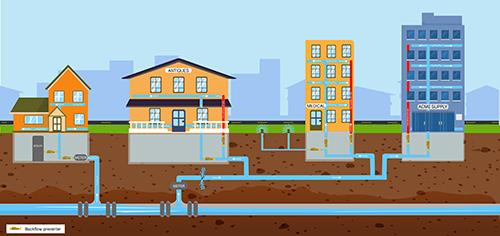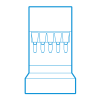Cross-Connections and Backflow Prevention: Ensuring Safe Drinking Water
Key details on how you can protect your water supply through cross-connection control and backflow prevention.
Key details on how you can protect your water supply through cross-connection control and backflow prevention.
Professionals should refer to the Code when making design, installation and maintenance decisions. This comprehensive document covers applications, testing, backflow prevention and more.
WSSC Plumbing and Fuel Gas Code
Cross-connection means any physical connection or a potential arrangement between any part of a potable water system and any other environment containing substances in a manner that, under any circumstances, would allow such substances to enter the potable water system or cause pollution or contamination of potable water system.
Backflow is the undesirable reversal of flow of a liquid, gas or other substances in a potable water distribution piping system as a result of a cross-connection.

Click image to enlarge.
Hydraulic events, such as:
Compliance may help reduce your liability. If you are responsible for a cross-connection — whether unprotected, improperly protected or out-of-date for service — and a backflow event occurs, you may be held liable for any resulting illness, death or property damage.
The Maryland State Plumbing Code and the WSSC Plumbing and Fuel Gas Code regulate cross-connection control and backflow prevention requirements. Only registered licensed WSSC Water Journeymen or Master Plumbers who are also certified cross-connection technicians are allowed to test and repair backflow prevention assemblies.
Cross-connection technicians must be registered and properly licensed with WSSC Water. Journeyman and Master Plumbers certified as cross-connection technicians will have completed an initial WSSC Water-approved 32-hour certification course (recertified every 3 years).
Under Maryland Law, only firms registered under a licensed Master Plumber can perform plumbing services, including backflow prevention assembly installation, repair and testing. Therefore, cross-connection technicians must be working under the direction of a WSSC Water registered and licensed Principal Master Plumber.
The Federal Safe Drinking Water Act mandates that public water systems comply with specific requirements regarding cross-connections and backflow prevention and authorizes the Environmental Protection Agency to oversee them. Organizations that source, treat and distribute drinking water, like WSSC Water, are required to implement a cross-connection control plan after approval from their regulator.
WSSC Water thoroughly inspected our treatment plants and pumping stations to ensure that we are in full compliance. Inspections then took place on a priority-based matrix, giving the highest priority to commercial properties with the highest degree of hazards, while also assessing their hydraulic vulnerability.
Approved modern plumbing fixtures (like sinks, toilets, dishwashers) have built-in backflow protection, such as air gaps. However, certain systems, such as lawn irrigation, hydronic heating (boiler) systems, cooling towers, water-operated sump pump backup systems, fire sprinkler systems and continuous direct pressure conditions require additional backflow protection. Additional protection is also important in commercial and industrial applications where continuous direct pressure connections are needed for water flow.
Cross-Connection Test Reporting
The list below are examples of testable applications. Refer to Chapter 5 of the WSSC Water Plumbing and Fuel Gas Code for a complete list.
 | Irrigation (Homes & Businesses) |
 | Medical Equipment, Laboratories |
 | Car Wash |
Refer to Chapter 5 of the WSSC Water Plumbing and Fuel Gas Code for a complete list.
 | Residential Boilers |
 | Commercial Ice Makers |
 | Carbonated Beverage Dispensers |

WSSC Water needs your help to catch-up on years of non-reporting and non-compliance. Customers are asked to complete a self-survey of all connections on their property. Complete your self-survey today.
The self-survey can be completed by the owner, tenant or a plumber. For accurate results, ensure that both owners and tenants share this notice. Homeowners with testable backflow assemblies may also complete a self-survey via phone or email.
Contact Us:
When seasonal water use systems such as irrigation systems, pools, pool houses, and summer homes are reactivated, the connected backflow assemblies must be tested and the WSSC Plumbing and Fuel Gas Code requires that the test results be electronically submitted to WSSC Water.
Tip for owners: Consider including backflow testing to your spring start-up contract for pools and irrigation systems.
WSSC Water Code officials, engineers, plumbing installers and property owners ensure proper backflow protection in new construction buildings. However, ongoing maintenance is necessary to keep systems functioning properly.

Our eleven dedicated inspectors who cover the service area are actively identifying unprotected or improperly protected cross-connections based on priority.
Backed by a strong administrative team, we maintain our database, send reminders, and run our self-survey program to keep everything running smoothly.